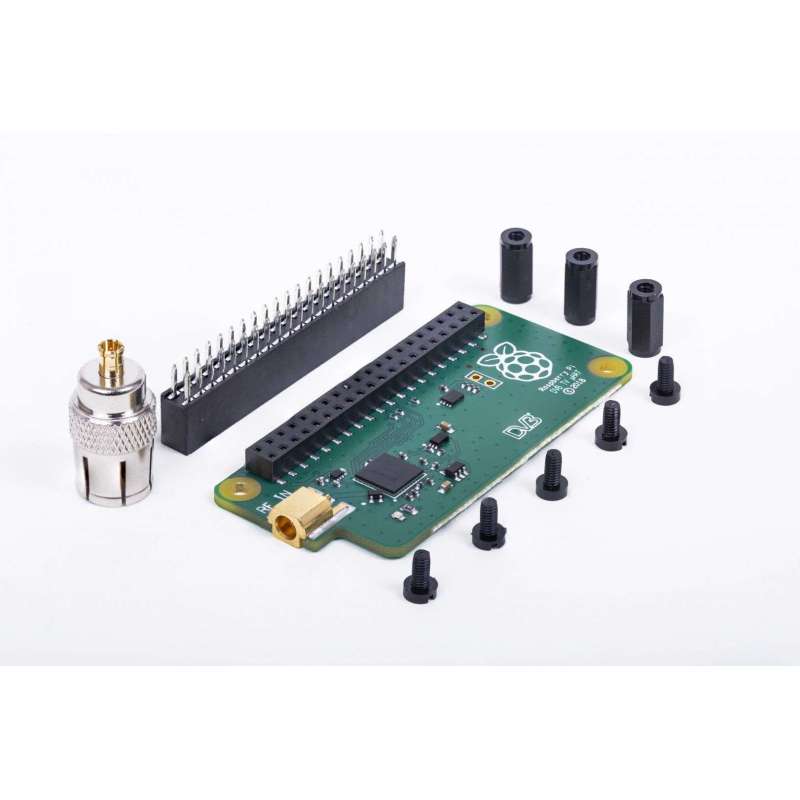




RLX COMPONENTS s.r.o. , Electronic Components Distributor.
RLX COMPONENTS s.r.o. , Electronic Components Distributor.
RASPBERRY PI TV HAT (DVB-T & DVB-T2 uHAT)
We’ve put together a downloadable step-by-step guide to Getting started with the TV HAT, which walks you through the complete setup process.
The Raspberry Pi TV HAT has a DVB-T2 and DVB-T tuner on board, which allows you to receive and decode digital television streams on your Raspberry Pi.
More detailed information on Raspberry Pi hardware is available.
Raspbian Stretch (or later) is required for using the TV HAT. Download the latest version of Raspbian here.
For how to install Raspbian, see our online guide to Getting started with your Pi.
The software we recommend for decoding TV streams and viewing content is TVHeadend. Instructions for setting this up are in our guide to Getting started with the TV HAT.
Connect a coaxial RF cable from a TV aerial socket to the RF adapter on the TV HAT. You’ll need decent digital terrestrial TV (Freeview in the UK) reception for the tuner to work. With Raspbian Stretch installed on its microSD card, turn on the Raspberry Pi – a green LED will light on the TV HAT.
We need to install a back-end TV service to stream video: we’ll use Tvheadend. To install it, open a Terminal window and enter:
|
1
2
|
sudo apt-get update
sudo apt-get install tvheadend
|
It takes a few minutes for Tvheadend to install, so you may want to go and make a cup of tea. Once installed, a package configuration screen will appear and you’ll be prompted to enter a Tvheadend administrator user name. For simplicity’s sake, enter kodi for this, then also enter kodi for the password – you can always change it later if you prefer. You’re now ready to log in from another device.
Now that Tvheadend is running, you can access it from another computer (possibly a second Raspberry Pi). In a web browser, enter this address: http://raspberrypi.local:9981/extjs.html.
If that doesn’t resolve, use the Pi’s IP address instead, followed by :9981/extjs.html. Log in using kodi for both the user name and password. A configuration wizard will appear, enabling you to choose the TV network type and transmitter.
In the configuration wizard’s ‘Network settings’, it should show ‘Tuner: Sony CDX2880 #0 DVB-T #0’. For the Network Type, choose ‘DVB-T Network’. For predefined muxes, select your local transmitter: for example, ours was uk-Rowridge. Upon clicking Save & Next, it’ll start scanning for muxes and services (channels). After it reaches 100%, tick all three boxes (Map all services, Create provider tags, Create network tags) and an electronic programme guide (EPG) will appear.

You can access the EPG and watch live TV in a web browser on a remote computer
You can now watch live TV streamed from the TV HAT in your browser. In the EPG, click the TV icon to the left of any programme to show it in a window, which you can expand to full-screen. There are also options to schedule and record shows – use the Help option for more details.
As well as using a web browser, you can view the TV stream from a variety of clients, including Kodi, omxplayer, VLC, and smartphone apps – you can find a full list on the Tvheadend website.
The live TV stream from the TV HAT can be accessed in the Kodi media player, most easily by using the LibreELEC OS on a Raspberry Pi. Install the Tvheadend client by selecting Add-ons > Install from repository > PVR clients > Tvheadend HTSP Client.
To make TV recordings, you’ll need to create a recordings folder on a connected USB stick or hard drive – navigate to it in File Manager, right-click, and select ‘Make new folder’). Then, in the web interface on a remote computer, go to Configuration > Recordings and set the recording system path tovar/media/[your_drive_name]/recordings.